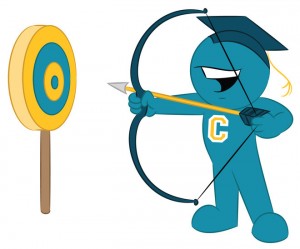Kids and athletes have grown up watching colleges with strong athletic programs dominate  the airwaves on ESPN and other television stations. They have become so familiar with the “glamorous” athletes and coaches that it becomes their main impression of college sports. But for 99% of high school athletes who go on to compete in college, this ESPN life will be nowhere close to their own experience.
the airwaves on ESPN and other television stations. They have become so familiar with the “glamorous” athletes and coaches that it becomes their main impression of college sports. But for 99% of high school athletes who go on to compete in college, this ESPN life will be nowhere close to their own experience.
High school athletes who are trying to get recruited to play in college all have the same goal. They want to find a program that will give them a scholarship to compete in their sport, while earning a degree. The competition to find an opportunity like this is very high, so it won’t come easy. Unfortunately, many high school athletes are fixated on the high-profile Division I programs that they see on ESPN. Most of these athletes will not play for DI teams when they go to college.
If you narrow your target schools to those only at the DI level, you are risking the chance of not finding a great opportunity. You need to look at colleges at the DII, DIII, and NAIA levels as well. Athletic programs at these levels also have scholarships available at great schools where you can earn your degree. The chances of you being good enough to play a sport at the DI are too small to bet your entire recruiting efforts on. That’s why it is always a good idea to know what level you should be targeting to get the most responses.
Here are three ways to help you determine which level of college sports is best for you and where you should target your recruiting efforts:
– Get a third-party evaluation: Sports camps and combines were developed to help athletes and coaches assess and evaluate the skill level of athletes as they get ready for college sports. By attending one, you can get close attention from coaches who can tell you your strengths and weaknesses and how to improve on them. You will also get a good look at other athletes around you and how you stack up against them.
– Ask your High school or club coach: This coach knows your skills better than most people so they are a crucial source of information when it comes to knowing what division level you should target. Take some time and talk to them about where they think your athletic future lies.
– Send your video to college coaches: Getting exposure is the most important part of the recruiting process, so you need to send your video and resume to a lot of different programs and schools, preferably in different division levels. Based on the responses you get from coaches, you should be able to gauge what level might best be suited for you. For example, if you get a lot of attention from Division II coaches and no responses from Division I coaches, you are most likely going to find an opportunity at the DII level.
Do you know what level you should be playing at in college? Ask us your questions about the recruiting process by leaving a comment below or connect with us on Facebook and Twitter.